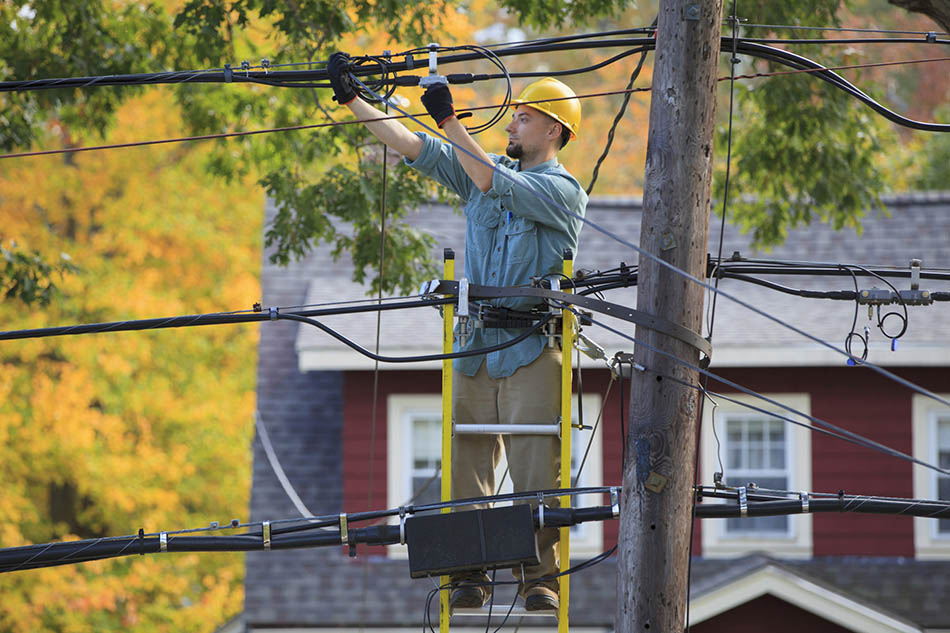Broadband Slowdown Forces Analyst to Go Negative on Cable Sector
Wells Fargo’s Steven Cahall downgrades distributors

Fueled by the inevitable slowdown of broadband subscriber additions, Wells Fargo media analyst Steven Cahall lowered his estimates on four cable distribution stocks, adding that as penetration rates rise and DSL competition sputters, the sector could be entering a period of diminished profitability.
Cahall reduced his estimates for Comcast, Charter Communications, Altice USA and Cable One on Friday, reflecting the slowing of broadband subscriber additions. While Cahall said that the slowdown is not a surprise: Most cable operators have warned for months that subscriber additions would be lower as pandemic lockdowns disappeared and workers returned to their offices. But Cahall wrote that adding to the pressure is increased penetration of homes with annual household incomes above $25,000 — now at about 100% — and the continued slide of digital subscriber line service. Cahall estimated that slower-speed DSL, a ripe target for cable broadband service, especially in rural markets, has seen its penetration rates dip from 25% about five years ago to 14% today.
“So there is a lot less low-hanging fruit,” Cahall wrote.
Despite Altice USA’s admission that broadband adds will go negative in Q3, Cahall didn’t lower his rating on the stock — it stayed at “Equal Weight” — mainly because he doesn’t believe the company has much further to fall. But he did reduce his 12-month price target on the stock to $21 from $34 per share.
Other stocks weren’t so lucky. Cahall reduced his rating on Charter (to “Underweight” from “Overweight”) and his price target to $665 per share from $848. At Cable One, Cahall’s rating fell to “Equal Weight” from “Overweight”, while his price target dropped to $2,100 per share from $2,400.
He kept his “Underweight” rating for Comcast, but reduced his price target to $41 per share from $49.
Comcast said earlier last month that it expects broadband growth to soften in Q3, and Altice USA CEO Dexter Goei shook the market when he told a virtual audience at the Goldman Sachs Communacopia conference that the operator would lose between 15,000 and 20,000 broadband customers in Q3. Altice USA stock has been down about 24% since Goei made that statement on Sept. 23, and Cahall said it has in turn caused analysts to take a harder look at growth rates earlier in the year.
Multichannel Newsletter
The smarter way to stay on top of the multichannel video marketplace. Sign up below.
Also Read: Did Altice USA Cut Costs Too Much?
“We're starting to see cracks in the growth story with recent management commentary from our coverage,” Cahall wrote. “Ultimately, we expect growth to decelerate from here as penetration is nearing its peak, competition is beginning to heat up in a meaningful way, and cable capex remains elevated.”
In his note, Cahall said that he now estimates that the Federal Communications Commission’s $3.2 billion Emergency Broadband Benefit program, which offers eligible residents up to $50 per month in broadband discounts, could account for as much as 20% of net broadband customer additions on an annualized basis. That paints a gloomier picture for future broadband growth -- most investors believe 2022 growth rates will be in line with 2019 performance -- Cahall wrote. He added that move churn, which helped operators in the first half of the year, could hurt them in the last half of 2021.
“We expect move churn to be up overall in 2022 due to pent-up demand from the pandemic,” Cahall wrote. “Along with more competition from fiber and fixed wireless, these analyses underlie our cuts to 2022-23 broadband net adds.”
Broadband Slowdown Foreseen
Overall, Cahall expects the cable distribution sector to add about 590,000 broadband customers in Q3, down 21.8% from his previous forecast of 755,000 additions. For the full year, he predicts cable broadband subscribers will rise by 2.9 million (down from his previous estimate of 3.2 million), slipping to 2.4 million additions in 2022 and 2 million by 2023.
Also Read: How Slow Will the Broadband Slowdown Be?
Altice USA is expected to take the hardest hit, adding just 6,000 broadband customers in 2021 (down from his previous estimate of 53,000 additions) according to Cahall’s estimates. Growth will pick up in 2022 to 62,000 customers (compared to 72,000 in 2019), slipping to 54,000 in 2023.
Charter Communications is expected to add 305,000 broadband customers in Q3 (down from previous estimates of 341,000) and about 1.31 million for the new year, slightly behind the analysts previous target of 1.375 million additions. At Comcast, broadband adds should be around 295,000 in Q3, down from his previous mark of 395,000 additions. Food the full year, Cahall now expects Comcast to add about 1.44 million broadband customers, in stead of the 1.645 million additions he previously predicted.
Cable One, a pioneer in the broadband-only strategy that has spread across the sector in the past few years, should add about 10,000 broadband customers in Q3, in line with previous predictions, and full-year adds will be even with Cahall's earlier estimate of 167,000 additions. But growth will slow in 2022 and 2023, with Cahall predicting 31,000 and 32,000 adds for those years, respectively.
Mike Farrell is senior content producer, finance for Multichannel News/B+C, covering finance, operations and M&A at cable operators and networks across the industry. He joined Multichannel News in September 1998 and has written about major deals and top players in the business ever since. He also writes the On The Money blog, offering deeper dives into a wide variety of topics including, retransmission consent, regional sports networks,and streaming video. In 2015 he won the Jesse H. Neal Award for Best Profile, an in-depth look at the Syfy Network’s Sharknado franchise and its impact on the industry.

